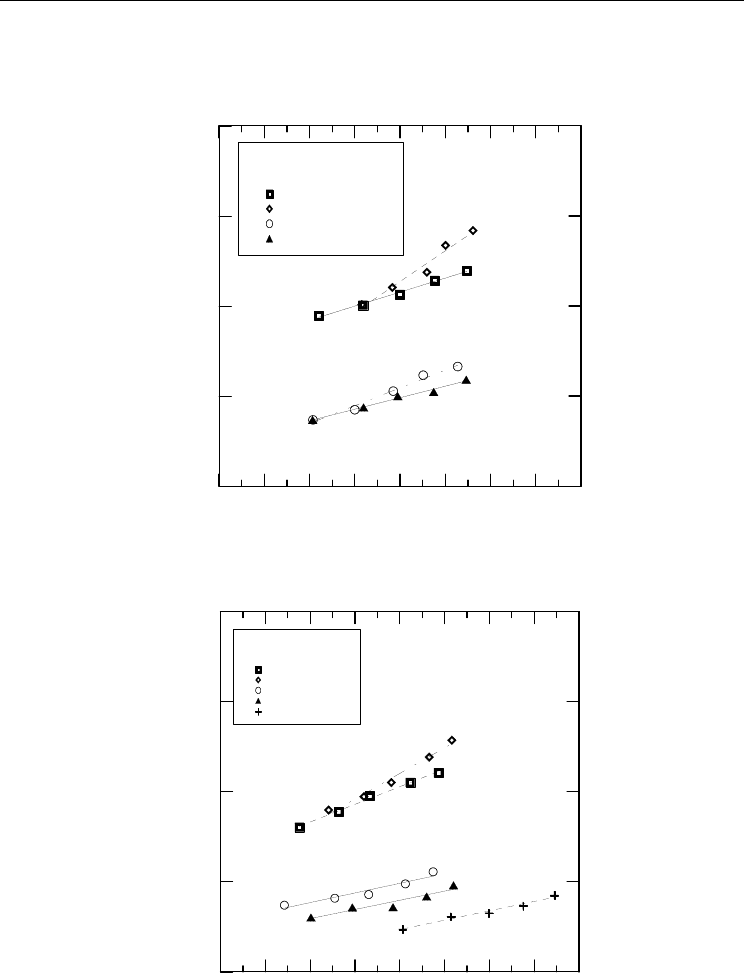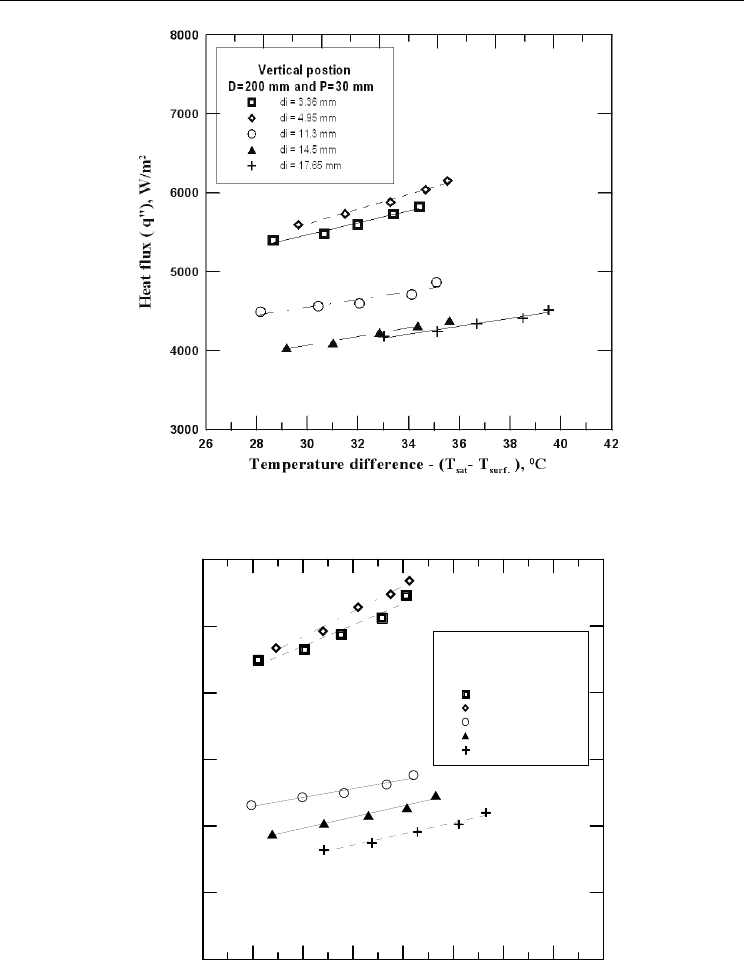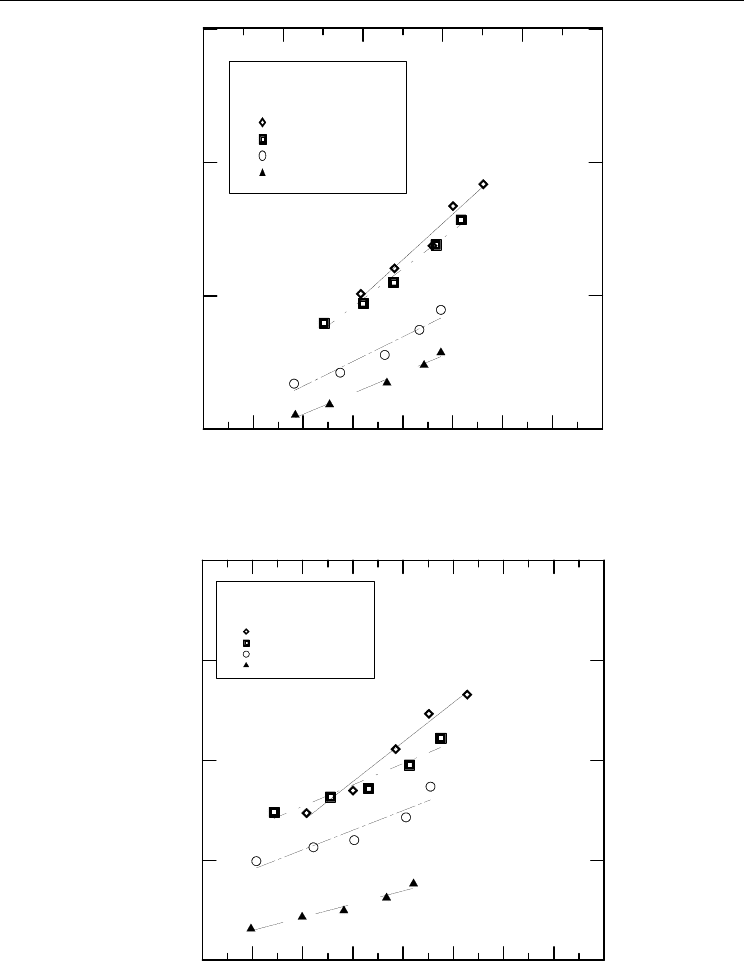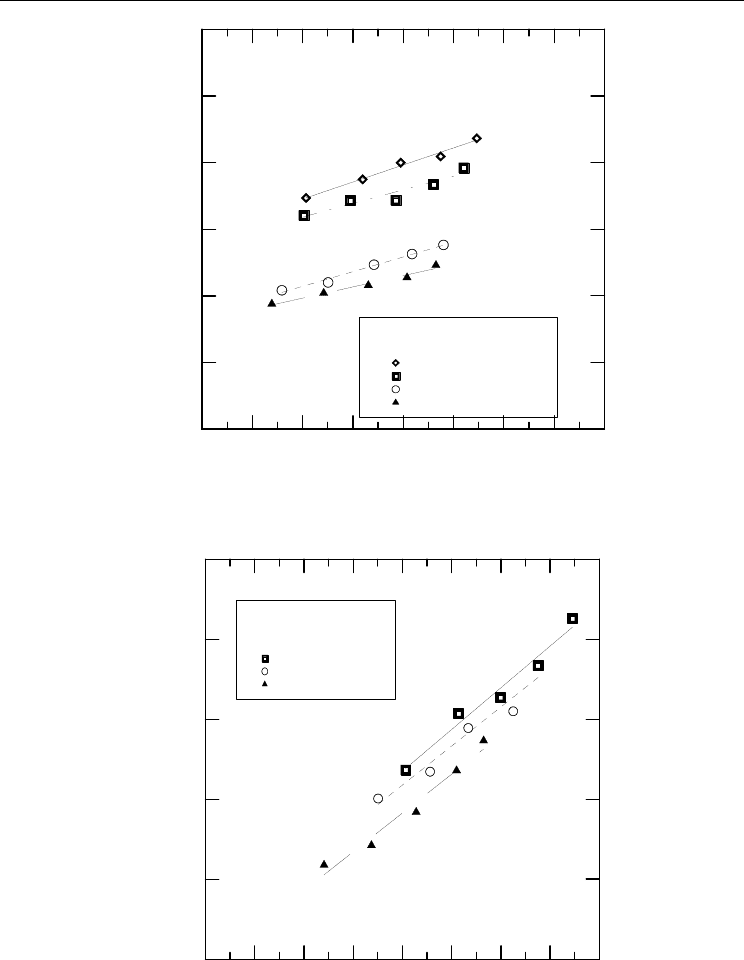Ahsan A. (ed.) Evaporation, Condensation and Heat transfer
Подождите немного. Документ загружается.

8
Experimental Study for Condensation Heat
Transfer Inside Helical Coil
Mohamed A. Abd Raboh
1
, Hesham M. Mostafa
2
,
Mostafa A. M. Ali
2
and Amr M. Hassaan
3
1
Faculty of Engineering, Al Azhar University,
2
Faculty of Engineering, King Abdulaziz University,
3
Higher Technological Institute, Tenth of Ramadan City,
1,3
Egypt
2
K.S.A
1. Introduction
Heat exchangers are one of the most common technological devices applied in refrigeration,
air-conditioning, nuclear power generation, petrochemical, pharmaceutical, aerospace
industries and food processing industries. Many options are available for obtaining
compactness and efficiency in exchanging thermal power. In the field of tubular heat
exchangers one possible way for reducing the space occupied by the exchanger is by
bending tube axis in helicoidal shape. This option is particularly suitable when construction
simplicity is needed and when the geometry of the place in which the exchanger has to be
housed is the cylindrical one. Many advantages derive from this disposition, such as an
excellent behavior in presence of severe thermal expansions; in fact the helical shape allows
the exchanger to behave as a spring, thus accommodating the stresses due to the expansions.
Helicoidal pipes have been extensively studied and used in a variety of engineering areas
due to their high efficiency in heat transfer and compactness in volume. Han et al. [1]
investigated the condensation heat transfer and pressure drop characteristics of R-134a in an
annular helical pipe. The obtained results show that the refrigerant-side condensation heat
transfer coefficients and pressure drops of R-134a increase with the mass flux of R-134a. The
saturated temperatures have significant effects on the condensation heat transfer coefficients
of R-134a in the annular helical pipe. Lin and Ebadian [2] investigated the condensation heat
transfer and pressure drop of R-134a in annular helicoidal pipe at different orientations. The
results shows that, the effect of individual parameter revealed that the refrigerant Nusselt
number was larger at lower refrigerant saturation temperature, and would increase with the
increase of mass flow rates of both refrigerant and cooling water. When the orientation
increased from 0 degree to 90 degree, the percentage increase of refrigerant Nusselt number
from 0 degree to 45 degree accounted for more than two times of that from 45 degree to 90
degree. Han et al. [3] investigate the condensation heat transfer of R-134a flow inside helical
pipes at different orientations. The obtained results show that, the condensation heat
transfer coefficient from the refrigerant side for the helical pipe at the inclined position is the
highest, and the vertical position is the lowest. Laohalertdecha and Wongwises [4] studied
the effect of corrugation pitch on the condensation heat transfer coefficient and pressure

Evaporation, Condensation and Heat Transfer
170
drop of R-134a inside horizontal corrugated tube. Murai et al. [5] studied structure of air–
water two-phase flow in helically coiled tubes. The obtained results shows that, owing to the
curvature of the tube, which provides centrifugal acceleration to the two-phase flow, the
flow transition from bubbly to plug flow is considerably quickened compared to that in the
flow in a straight tube. Also, in comparison with an upward inclined straight tube, small
bubbles vanish away from the liquid slug in the case of a strong curvature owing to the
centrifugal acceleration. Wongwises and Polsongkram [6] investigated the condensation
heat transfer and pressure drop of R-134a in a helically coiled concentric tube-in-tube heat
exchanger. Their obtained results show that, the average heat transfer coefficient increases
with increasing average vapor quality and mass flux. The heat transfer coefficient increases
very slightly with an increase in heat flux. On the contrary, it decreases with increasing
saturation temperature. Li and Ji-tian [7] investigated the condensation heat transfer of R-
134a in horizontal straight and helically tube in tube heat exchanger. Their results show that,
the average heat transfer coefficient for the helical section is 4%-13.8% higher than that for
the straight section. M. Moawed [8] investigated the forced convection from helical coiled
tubes with different parameters. Their results showed that, for the same P/do, the higher
values of Nusselt number (Nu
m
) can be obtained with a high value of D/do while the small
value of Nu
m
can be obtained with a small value of D/do. Al-Hajeri et al. [9] investigated
heat transfer performance during condensation of R-134a inside helicoidal tubes. Their
experimental results show that, the average heat flux, refrigerant side heat transfer
coefficient and overall heat transfer coefficients increase with increasing of the mass flux of
flowing R-134a. The refrigerant side heat transfer coefficient and overall heat transfer
coefficient decrease as the saturation temperature increases. Xin et al. [10] investigated an
experimental study of single-phase and two-phase flow pressure drop in annular helicoidal
pipes. Wongwises and Polsongkarm [11] investigated the evaporation heat transfer and
pressure drop of HFC-134a in a helically coiled concentric tube-in-tube heat exchanger.
Condensation of R134a flowing inside helicoidal pipe investigated by Laohalertdecha and
Wongwises [12]. Their obtained results show that, the average heat flux of the refrigerant
flow increases with the water flow rate.
It is clear from the previous review and up to the knowledge of the authors that, there is a
shortage in thesis which concerned with condensation of steam inside helical coil.
Accordingly, in this work, an experimental study is done to investigate the effect of different
operating parameters on the condensation heat transfer coefficient for steam flows inside
helical coil.
2. Experimental test rig
The experimental test rig is illustrated in Fig. 1. It is mainly consists of a circular inlet
section, a rectangular cross section duct in which the tested helical coil is installed, and the
heating steam loop. Air is drawn from the ambient by the blower 2.5 hp rated power (2). A
flexible connection (3) separates the blower section and the rest of the wind tunnel to
eliminate any vibrations promoted. The leaving air from the blower flows through a velocity
meter (8) to measure the average air velocity inside the wind tunnel.
Wind tunnel (4) walls are made of galvanized iron sheet of 1 mm thick. The basic
dimensions for the wind tunnel are 2.5 m long, 670 mm wide and 330 mm high. Tested
helical coil with different dimensions is fitted, vertical or inclined, at the middle of the test
section, as shown in Fig. (1). To insure that a fully developed flow is achieved at the
entrance of the test section (7), air is traveled through the entrance region (6) of 2 m long,

Experimental Study for Condensation Heat Transfer Inside Helical Coil
171
which having the same rectangular cross section as that of the test section. Also, outlet air
flows through bell mouth which installed at the exit section of the wind tunnel.
The helical coil was tested inside the wind tunnel at different operating parameters. The
tested operating parameters are; pipe diameter, coil diameter, coil pitch, and coil
orientations. All tested helical coils have the same outer surface area (0.1 m
2
). Five values of
inner diameters of pipe are tested; 3.36, 4.95, 11.3, 14.48 and 17.65 mm. The tested helical coil
was wrapped at five different coil diameters as; 100, 125, 150, 200, and 250 mm. Also; the
helical coil was formed at different coil pitches (20, 30, 40, and 50 mm). The tested helical
coil orientations are vertical (90 degree) and inclined positions with different angles (30, 45,
60 degree). The outer surfaces of the tunnel walls are completely insulated with 30 mm glass
wool to minimize the heat loss.
Heating steam loop consists of electric boiler and water separator. The basic dimensions of
the electric boiler are 0.4 m in diameter and 0.6 m height. Two electric heaters (each one 1.5
kW rated power) are used. Each electric element is controlled through automatic switch
with max load of 20 A; to protect the boiler from over load hazards and to control the
required amount of heating steam. Safety valve was set to 3 bar and fixed at the upper port
of the boiler. Also, pressure gauge was fit to the boiler upper port to monitor the steam
pressure inside the boiler. The steam line includes a back pressure valve (10) to assure
the steady stream flow with a selected heating steam pressure , a regulator (11) to
control the amount of steam mass flow rate needed. The generated steam from electric
boiler is naturally moved to water separator and leaves it in dry saturated condition. Then,
heating steam passes through the helical coil and it is condensed inside it. The steam
condensate is collected in a calibrated glass tube in a certain time to measure the condensate
flow rate, and a thermocouple is fit to the condensate line to measure the condensate
temperature outlet from tested helical coil.
Level indicator 15- Velocity meter 8- Electric motor 1-
Safety valve 16- Test helical coil 9- Blower 2-
Exit bill mouse 17- Back pressure valve 10- Flexible connection 3-
Burette 18- Regulator 11- Wind tunnel 4-
Drain D Water separator 12- Screen 5-
Flow rate F Vent valve 13- Entrance region 6-
Pressure P Electric boiler 14- Entrance test section 7-
Temperature T
Fig. 1. Schematic diagram of the experimental test rig

Evaporation, Condensation and Heat Transfer
172
3. Measurements and methodology
The experimental measurements are taken to determine the condensation heat transfer
coefficient for the steam which flows inside helical coil. Prior to start of the experiments, the
electric boiler filled with suitable volume of water. Glass level indicator was fixed in the side
of the boiler to monitor the water level inside the boiler. The generated steam moves into the
water separator to get it dry saturated steam. The steam was getting out from the water
separator to the back pressure valve to get the suitable pressure which needed in the
experiment. Then the regulator control the required amount of steam passed to the tested
helical coil to condense inside it due to air flowing inside the wind tunnel on the outer
surface of the coil. The experimental test rig is allowed to operate until the fluctuation in
temperatures was about ±0.1 ºC. Then, steady state condition is reached. Once the test rig is
reached to the desired steady state condition, the required measurements of temperature,
pressure and volume flow rate are taken. Temperatures of inlet heating steam at inlet and
condensate outlet from each tested helical coil are measured. Surface temperature, inlet and
outlet air temperatures and other temperatures in different positions are measured by using
0.5 mm copper-constantan thermocouple (type k), which connected to a temperature
recorder via multi point switch having an accuracy of ± 0.1 ºC. The uncertainty in
temperature measurements is ±0.1 ºC. Due to the small amount of condensate from coil a
calibrated constant volume tank and stop watch is used. Inlet steam pressure is measured by
Bourdon pressure gauge with minimum readable value of ± 0.05 bar. Air velocity was
measured by a hot wire anemometer sensor (type Testo 605-V1, of 8mm probe diameter),
with a resolution of 0.01 m/s. The root-mean-square random error propagation analysis is
carried out in the standard fashion using the measured experimental uncertainties of the
basic independent parameters. The experimental uncertainties associated with these
measurements technique are estimated to be approximately less than 12 % for condensation
heat transfer coefficient.
4. Data reduction
The basic measurements are analyzed using a computer reduction program to calculate the
condensation heat transfer coefficient. At steady state, the total input heat from the heating
steam which flows inside the helical coil (Q
st
) can be transferred to the flowing air inside wind
tunnel. It is divided into useful heat to air (Q
air
) and the remaining amount of heat transferred
to the surroundings as heat loss (Q
loss
). The total input heat can be determined as follow;
st st
g
o
Q=m(i-i)·
(1)
Where;
m
.
st
: Steam flow rate inside helical coil, kg/s.
i
g
: Specific enthalpy for dry saturated steam evaluated at the steam inlet pressure to
the tested coil, J/kg.
i
o
: Specific enthalpy for condensate at the outlet from test coil, J/kg.
The useful heat transfer to air flow inside the wind tunnel can be calculated from measuring
mass flow rate which flow inside the helical coil and the temperature rise in the air as;
()
.
air air air air,o air,i
QmCp T T=−
(2)
Where:

Experimental Study for Condensation Heat Transfer Inside Helical Coil
173
m
.
air
: Mass flow rate of air in the wind tunnel, kg/s.
Cp
air
: Specific heat of air, J/kg
o
C.
T
air,i
: Inlet air temperature,
o
C.
T
air,o
: Outlet air temperature,
o
C.
Then, the amount of heat loss from the test section to the surrounding (Q
loss
) can be
determined as the difference between input heat and useful heat as;
loss st air
Q Q Q=− (3)
Heat flux (q") can be calculated from the following equation as;
st s,i
q" Q / A= (4)
Where;
A
s,i
: Inner surface area of the pipe forming the tested helical coil, (A
s,i
= пd
i
L).
d
i
: Inner pipe diameter, m.
L : Pipe length, m.
Accordingly, the condensation heat transfer coefficient (h
c
) can be calculated as;
()
''
sat s,i
h q / T T=−
(5)
Where:
T
sat
: Saturation temperature for heating steam,
o
C.
T
s,i
: Average value for the inner surface temperature of the pipe,
o
C.
Reynolds number can be defined as:
4
Re
st
i
m
d
π
μ
∗
=
·
(6)
Where:
µ: dynamic viscosity of steam at average bulk temperature.
The average values for the Nusselt number (
Nu), could be evaluated as,
i
hd
Nu
k
∗
=
(7)
Where,
k: Thermal conductivity for working fluid.
5. Results and discussion
Appropriate analysis for the experimental measurements; lead to obtain the heat flux and
condensation heat transfer coefficient for different operating parameters. The studied
operating conditions are pipe diameter, coil diameter, coil pitch, and coil orientations. All
tested helical coils have the same outer surface area (0.1 m
2
).
5.1 Effect of inner pipe diameter
The variation of heat flux versus temperature difference for different values of inner pipe
diameters (
di =3.36, 4.95, 11.3, 14.48 and 17.65 mm) at vertical position with coil pitch (P =30
mm) are shown in figures (2). It is observed that, for all the studied coil diameters (100, 125,
150, 200 and 250 mm), heat flux increases with decreasing inner pipe diameter until it reach

Evaporation, Condensation and Heat Transfer
174
to the maximum value at inner pipe diameter equal to 4.95 mm. Then it decreases with
decreasing inner pipe diameter to 3.36 mm due to capillary effects. Also, heat flux increases
with increasing temperature difference. Therefore the optimum value for inner pipe
diameter was found to be 4.95 mm.
26 28 30 32 34 36 38 40 42
Temperature difference (T
sat
- T
surf.
),
0
C
4000
5000
6000
7000
8000
Heat flux (q"), W/m
2
Vertical postion
D = 100 mm and P=30 mm
di = 3.36 mm
di = 4.95 mm
di = 11.3 mm
di = 14.5 mm
Fig. 2a. Heat flux versus temperature difference for different inner pipe diameters at P =30
mm and D =100 mm.
26 28 30 32 34 36 38 40 42
Temperature difference (T
sat
- T
surf.
),
0
C
4000
5000
6000
7000
8000
Heat flux (q"), W/m
2
Vertical postion
D=150 mm and P=30 mm
di= 3.36 mm
di = 4.95 mm
di=11.3 mm
di = 14.5 mm
di = 17.65 mm
Fig. 2b. Heat flux versus temperature difference for different inner pipe diameters at P =30
mm and D =150 mm.

Experimental Study for Condensation Heat Transfer Inside Helical Coil
175
Fig. 2c. Heat flux versus temperature difference for different inner pipe diameters at P =30
mm and D =200 mm.
26 28 30 32 34 36 38 40 42
Temperature difference (T
sat
- T
surf.
)
0
C
3000
3500
4000
4500
5000
5500
6000
Heat flux (q") ,W/m
2
Vertical postion
D=250 mm and P=30 mm
di= 3.36 mm
di = 4.95 mm
di=11.3 mm
di = 14.5 mm
di = 17.65 mm
Fig. 2d. Heat flux versus temperature difference for different inner pipe diameters at P =30
mm and D =250 mm.

Evaporation, Condensation and Heat Transfer
176
5.2 Effect of coil diameter
The variation of heat flux versus temperature difference for different values of coil
diameters (100, 125, 150, 200 and 250 mm) at vertical position with coil pitch (P =30 mm) are
shown in figures (3). It is observed that, for all the studied inner pipe diameters (di =3.36,
4.95, 11.3, 14.48 and 17.65 mm), heat flux increases with decreasing coil diameter. Also, heat
flux increases with increasing temperature difference. This can be attributed to the air flows
faster around the small coil diameter which give more cooling to the coil surface. Therefore
the optimum value for coil diameter was found to be 100 mm.
5.3 Effect of coil pitch
The variation of heat flux versus temperature difference for different values of coil pitches
(P= 20, 30, 40 and 50 mm) at vertical position with coil diameter (D =100 mm) and inner pipe
diameter (di =4.95 mm) is shown in Fig. (4). It is observed that, for the optimum values of
coil diameter and inner pipe diameter, heat flux increases with increasing coil pitch until it
reach to the maximum value at coil pitch equal to 40 mm. This can be explained as the flow
of air increases between the turns of the coil which give more cooling to the coil surface. But
increasing coil pitch than 40 mm leads to the coil takes more flat shape accordingly heat flux
decreases with increasing coil pitch (as shown in figure at 50 mm). Therefore the optimum
value for coil pitch was found to be 40 mm.
26 28 30 32 34 36 38 40 42
Temperature difference (T
sat
- T
surf.
),
0
C
5000
5400
5800
6200
6600
7000
Heat flux (q"), W/m
2
Vertical postion
di= 3.36 mm and P= 30 mm
D =100 mm
D=150 mm
D =200 mm
D=250 mm
Fig. 3a. Heat flux versus temperature difference for different coil diameters
at P =30 mm and di =3.36 mm.

Experimental Study for Condensation Heat Transfer Inside Helical Coil
177
26 28 30 32 34 36 38 40 42
Temperature difference (T
sat
- T
surf.
)
0
C
5000
6000
7000
8000
Heat
f
lux (q"), W/m
2
vertical postion
di =4.95 mm and P= 30 mm
D=100 mm
D = 150 mm
D=200 mm
D=250 mm
Fig. 3b. Heat flux versus temperature difference for different coil diameters
at P =30 mm and di =4.95 mm.
26 28 30 32 34 36 38 40 42
Temperature difference (T
sat
-T
surf.
),
O
C
4000
4500
5000
5500
6000
Heat flux (q") ,W/m
2
Vertical postion
di =11.3 mm and P= 30 mm
D = 100 mm
D=150 mm
D=200 mm
D=250 mm
Fig. 3c. Heat flux versus temperature difference for different coil diameters
at P =30 mm and di =11.3 mm.

Evaporation, Condensation and Heat Transfer
178
26 28 30 32 34 36 38 40 42
Temperature difference -(T
sat
- T
surf.
),
0
C
3000
3500
4000
4500
5000
5500
6000
Heat flux (q"), W/m
2
vertical postion
di= 14.5 mm and P= 30 mm
D=100 mm
D=150 mm
D= 200 mm
D=250 mm
Fig. 3d. Heat flux versus temperature difference for different coil diameters
at P =30 mm and di =14.48 mm.
26 28 30 32 34 36 38 40 42
Temperature difference -(T
sat
- T
surf.
) ,
0
C
4000
4200
4400
4600
4800
5000
Heat flux (q") ,w/m
2
Vertical postion
di =17.65 mm and P= 30 mm
D=150 mm
D=200 mm
D=250 mm
Fig. 3e. Heat flux versus temperature difference for different coil diameters
at P =30 mm and di =17.65 mm.
